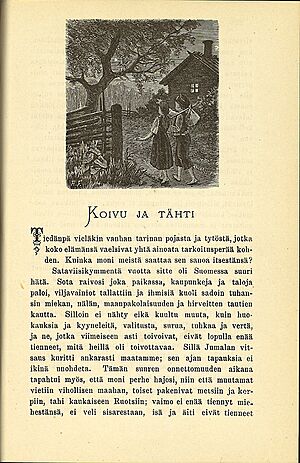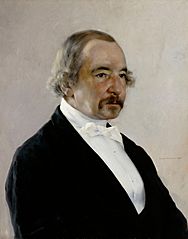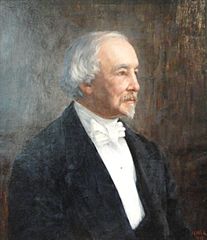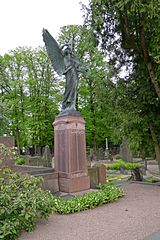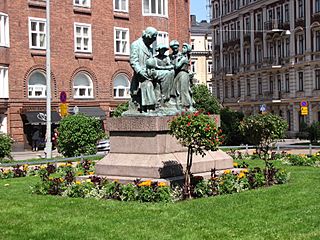Zachris Topelius facts for kids
Quick facts for kids
Zachris Topelius
|
|
|---|---|
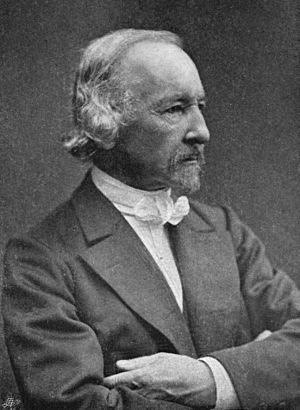 |
|
| Born | Zacharias Topelius 14 January 1818 Kuddnäs, near Nykarleby |
| Died | 12 March 1898 (aged 80) Sipoo, Grand Duchy of Finland, the Russian Empire (now Finland) |
| Occupation |
|
| Language | Swedish |
| Nationality | Finnish |
Zachris Topelius (born January 14, 1818 – died March 12, 1898) was a famous Finnish writer, poet, and historian. He also worked as a journalist and was even the head of the University of Helsinki. He wrote many novels about Finnish history in Swedish.
Contents
Life and Career of Zachris Topelius
Early Life and Family Background
Zachris Topelius was born as Zacharias Topelius. Even though his birth name was Zacharias, he often used the shorter name Zachris. This is why most people know him as Zachris today.
His family's original name was Toppila, which was a Finnish name. Over time, it changed to Toppelius and then to Topelius. Zachris was born in Kuddnäs, a place near Nykarleby in Pohjanmaa, Finland. His father, also named Zacharias Topelius, was a doctor and was known for collecting old Finnish folk songs. Zachris's mother, Katarina Sofia Calamnius, used to sing songs by the poet Franzén.
When Zachris was eleven, he went to school in Oulu. He lived with relatives who had a big library. This library was full of novels, and Zachris loved to read them. Reading these books helped his imagination grow.
Studying at the University of Helsinki
In 1831, Zachris moved to Helsingfors, which is now called Helsinki. There, he joined a group of young Finnish nationalists. These young men were inspired by the writer Johan Ludvig Runeberg, and Zachris even lived in Runeberg's home for a while.
Zachris started studying at the Imperial Alexander University of Finland in 1833. He worked hard and earned his master's degree in 1840. He later got his PhD in history in 1847. His studies included history, theology, and medicine. He also worked at the university library from 1846 to 1861. During this time, he taught history and Swedish at a school called Helsingfors lyceum.
Becoming a University Professor
In 1854, Zachris Topelius became a special professor of Finnish History at the university. This happened with the help of his friend, Fredrik Cygnæus. Later, in 1863, he became a full professor of Finnish, Russian, and Nordic history. He then switched to teaching general history in 1876.
From 1875 to 1878, he was the rector (the head) of the university. After that, he retired as a professor. He received an honorary title called verkligt statsråd, which means "state councillor."
Focusing on His Writing Career
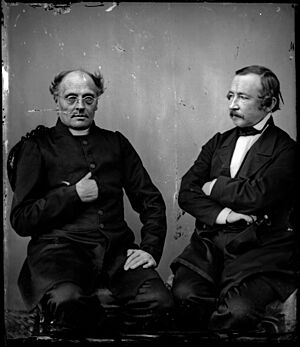
Zachris Topelius started writing poetry early in his career. He published three books of poems called Heather Blossoms between 1845 and 1854. His first historical novel, The Duchess of Finland, came out in 1850. He was also the main editor for a newspaper called Helsingfors Tidningar from 1841 to 1860.
When he retired from his university duties in 1878, he had more time for his many writing projects. One of his most popular works is Tales of a Barber-Surgeon. This is a series of historical stories about Finland, set during the time of kings like Gustavus II Adolphus and Gustavus III. These stories were written in a style similar to the famous writer Walter Scott. The five volumes of this work were published between 1853 and 1867.
Topelius also tried writing plays. His most successful play was the tragedy Regina von Emmeritz (1854). He wanted his writings to encourage a strong sense of Finnish patriotism. He wrote a poem that the famous composer Jean Sibelius used for a musical piece called Islossningen i Uleå älv.

He also wrote the story (called a libretto) for the first Finnish opera, Kaarle-kuninkaan metsästys (Kung Karls jakt). He worked with the composer Friedrich Pacius on this project. The story was written in Swedish, but it was very much about Finnish themes. He also wrote the libretto for another opera called Prinsessan av Cypern.
Many of his stories used hidden meanings and old symbols. Some of his shorter works also looked at how the growth of factories and industry affected Finnish society.
Death and Burial
Zachris Topelius passed away in his home in Koivuniemi, Sipoo, Finland. This is where he wrote many of his most important works. He is buried in the Hietaniemi Cemetery in Helsinki.
Legacy and Influence
Zachris Topelius left a lasting mark on Finland. It is believed that the design for the modern flag of Finland was based on an idea by Topelius around 1860.
There was even a small village in Minnesota, USA, named after him in 1901. It was called Topelius.
Selected Works by Zachris Topelius
Here are some of Zachris Topelius's well-known works:
- The Tomten in Åbo Castle, 1849 (Tomtegubben i Åbo slott, Turun linnan tonttu-ukko)
- Sov du lilla vide ung, 1869 (Trollsländan)
- Boken om vårt land, 1875 (Maamme-kirja, Book of Our Land)
- Vinterqvällar, 1881 (Talvi-iltain tarinoita)
- Fältskärns berättelser, 1884 (Välskärin kertomukset)
- Läsning för barn, 1881 (Lukemisia lapsille)
- Stjärnornas kungabarn, 1899–1900 (Tähtien turvatit)
Images for kids
-
Portrait by Albert Edelfelt, 1889
See also
 In Spanish: Zacharias Topelius para niños
In Spanish: Zacharias Topelius para niños


